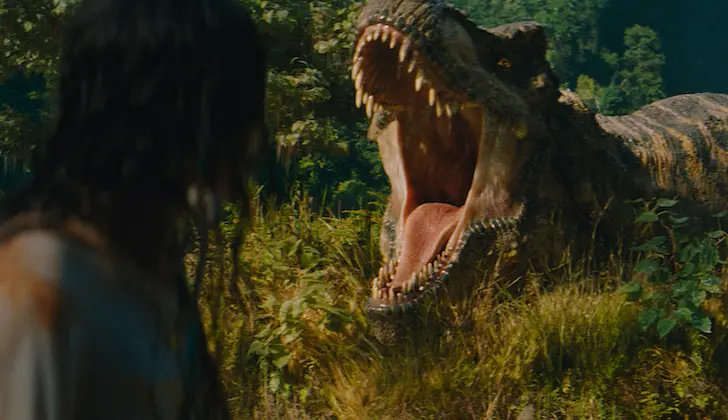The Jurassic Park film franchise, once a groundbreaking cinematic experience, is showing signs of fatigue with its latest installment, Jurassic World Rebirth. Directed by Gareth Edwards and penned by David Koepp, the film struggles to breathe new life into a series that has captivated audiences for over three decades. Despite its impressive visual effects, the movie falls short in delivering a compelling narrative, leaving viewers with a sense of déjà vu rather than excitement.
Set several years after the events of Jurassic World Dominion, Jurassic World Rebirth attempts to navigate a world where dinosaurs are once again on the brink of extinction. The film introduces Martin Krebs, a pharmaceutical executive played by Rupert Friend, who sees potential in dinosaur DNA for medical breakthroughs. However, the narrative quickly becomes mired in predictability and lacks the innovative spark that once defined the franchise.
A Familiar Plotline with Little Innovation
The storyline of Jurassic World Rebirth revolves around Krebs’ expedition to an abandoned island, previously home to an InGen research facility. Scarlett Johansson stars as Zora Bennett, a soldier tasked with leading the dangerous mission, alongside Jonathan Bailey’s Dr. Henry Loomis, a paleontologist with a dream of witnessing dinosaurs in their natural habitat. Despite the promising setup, the film fails to deliver a fresh take on the dinosaur adventure genre.
The plot is further complicated by the introduction of the Delgado family, whose encounter with amphibious dinosaurs adds little to the overarching narrative. The film struggles to balance its dual storylines, resulting in underdeveloped characters and a lack of cohesive storytelling. As critic John Doe notes, “The movie feels like a patchwork of ideas rather than a unified vision.”
Visual Spectacle Overshadowed by Weak Storytelling
While the film’s narrative may falter, its visual execution remains a highlight. Director Gareth Edwards showcases his talent for crafting visually stunning sequences, particularly in a thrilling river raft chase involving a Tyrannosaurus Rex. Cinematographer John Mathieson’s work enhances the film’s aesthetic appeal, capturing the grandeur of the dinosaurs and their environments.
“The river raft sequence is a standout moment, reminiscent of the original novel’s tension-filled scenes,” remarks film critic Jane Smith. “However, without a strong story to support it, the visuals alone cannot carry the film.”
Despite the impressive action sequences, the film’s reliance on mutant dinosaur hybrids detracts from the sense of wonder that traditional dinosaurs once evoked. The introduction of creatures like the D-Rex and Mutadons feels more like a gimmick than a meaningful addition to the franchise’s lore.
Missed Opportunities and Unanswered Questions
One of the film’s most glaring issues is its failure to address intriguing plot points. The existence of the island, with its mysterious temples and ruins, is introduced but never explored. This oversight leaves audiences questioning the logic behind the film’s world-building and the missed potential for a richer narrative.
Furthermore, the film’s characters lack depth, with many resembling archetypes from previous installments. The potential romantic chemistry between Bennett and Dr. Loomis is hinted at but ultimately goes nowhere, leaving viewers with a sense of unfulfilled potential.
The Franchise’s Future: A Need for Reinvention
As Jurassic World Rebirth concludes, it becomes apparent that the franchise is at a crossroads. The film’s reliance on rehashed ideas and lack of narrative innovation suggests a need for reinvention. With a production budget of $180 million, the film’s shortcomings highlight the importance of strong storytelling to complement visual spectacle.
Looking ahead, the franchise must find a way to recapture the magic that made the original Jurassic Park a cultural phenomenon. Whether through exploring new themes, introducing compelling characters, or revisiting the ethical dilemmas posed by genetic engineering, the series must evolve to remain relevant in a rapidly changing cinematic landscape.
“Jurassic World Rebirth is a reminder that even the most beloved franchises must adapt to survive,” observes entertainment analyst Mark Thompson. “Without innovation, the series risks becoming a relic of the past.”
In conclusion, Jurassic World Rebirth serves as a cautionary tale for the franchise, emphasizing the need for creative reinvigoration. As audiences continue to crave new and exciting stories, the future of the Jurassic Park series will depend on its ability to evolve beyond its current formula.
About The Author
 Stefanik Criticizes Columbia University Over Alleged Civil Rights Act Violation
Stefanik Criticizes Columbia University Over Alleged Civil Rights Act Violation Televangelist Jimmy Swaggart Dies at 90: A Legacy of Faith and Controversy
Televangelist Jimmy Swaggart Dies at 90: A Legacy of Faith and Controversy General Hospital Fans Theorize Sidwell’s Role in Natalia’s Death
General Hospital Fans Theorize Sidwell’s Role in Natalia’s Death Love Island USA Season 7 Episode 27: Release Date, Time, and Streaming Details
Love Island USA Season 7 Episode 27: Release Date, Time, and Streaming Details Dalai Lama Assures Continuation of Tibetan Buddhist Leadership Amidst China Tensions
Dalai Lama Assures Continuation of Tibetan Buddhist Leadership Amidst China Tensions